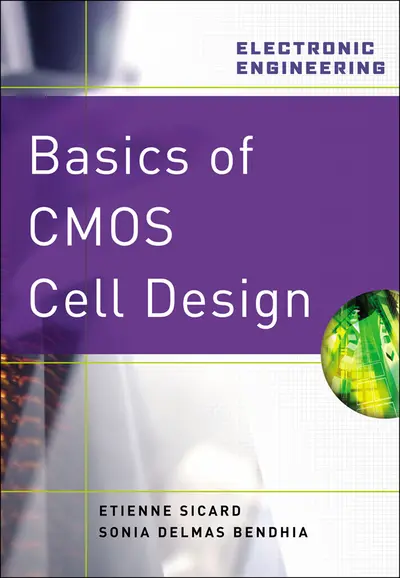My Account Details

ISBN10: 0071488391 | ISBN13: 9780071488396

Step 1 . Download Adobe Digital Editions to your PC or Mac desktop/laptop.
Step 2. Register and authorize your Adobe ID (optional). To access your eBook on multiple devices, first create an Adobe ID at account.adobe.com. Then, open Adobe Digital Editions, go to the Help menu, and select "Authorize Computer" to link your Adobe ID.
Step 3. Open Your eBook. Use Adobe Digital Editions to open the file. If the eBook doesn’t open, contact customer service for assistance.
Publisher's Note: Products purchased from Third Party sellers are not guaranteed by the publisher for quality, authenticity, or access to any online entitlements included with the product. Design and Simulate Any Type of CMOS Circuit! Electronic circuit designers and electronic engineering students can turn to Basics of CMOS Cell Design for a practice-based introduction to the design and simulation of every major type of CMOS (complementary metal oxide semiconductor) integrated circuit. You will find step-by-step explanations of everything they need for designing and simulating CMOS integrated circuits in deep-submicron technology, including MOS devices…inverters…interconnects…basic gates …arithmetics…sequential cell design…and analog basic cells. The book also presents design rules, Microwind program operation and commands, design logic editor operation and commands, and quick-reference sheets. Filled with 100 skills-building illustrations, Basics of CMOS Cell Design features: Expert guidance on MOS device modeling Complete details on micron and deep-submicron technologies Clear, concise information on basic logic gates Full coverage of analog cells A wealth of circuit simulation tools Inside This Landmark CMOS Circuit Design Guide— • MOS Devices and Technology • MOS Modeling • The Inverter • Interconnects • Basic Gates • Arithmetics • Sequential Cell Design • Analog Cells • Appendices: Design Rules; Microwind Program Operation and Commands; Design Logic Editor Operation and Commands; Quick- Reference Sheets
PrefaceAcknowledgmentsAbbreviations and SymbolsChapter 1: IntroductionChapter 2: The MOS Devices and TechnologyChapter 3: The MOS ModellingChapter 4: The InverterChapter 5: InterconnectsChapter 6: Basic GatesChapter 7: ArithmeticsChapter 8: Sequential Cell DesignChapter 9: Analog CellsAppendix A: Design RulesAppendix B: Microwind Program Operation and CommandsAppendix C: Dsch Logic Editor Operation and CommandsAppendix D: Quick Reference SheetGlossaryIndexSoftware Download InformationAuthors' Profiles
Abbreviations and SymbolsChapter 1: IntroductionChapter 2: The MOS Devices and TechnologyChapter 3: The MOS ModellingChapter 4: The InverterChapter 5: InterconnectsChapter 6: Basic GatesChapter 7: ArithmeticsChapter 8: Sequential Cell DesignChapter 9: Analog CellsAppendix A: Design RulesAppendix B: Microwind Program Operation and CommandsAppendix C: Dsch Logic Editor Operation and CommandsAppendix D: Quick Reference SheetGlossaryIndexSoftware Download InformationAuthors' Profiles
Chapter 2: The MOS Devices and TechnologyChapter 3: The MOS ModellingChapter 4: The InverterChapter 5: InterconnectsChapter 6: Basic GatesChapter 7: ArithmeticsChapter 8: Sequential Cell DesignChapter 9: Analog CellsAppendix A: Design RulesAppendix B: Microwind Program Operation and CommandsAppendix C: Dsch Logic Editor Operation and CommandsAppendix D: Quick Reference SheetGlossaryIndexSoftware Download InformationAuthors' Profiles
Chapter 4: The InverterChapter 5: InterconnectsChapter 6: Basic GatesChapter 7: ArithmeticsChapter 8: Sequential Cell DesignChapter 9: Analog CellsAppendix A: Design RulesAppendix B: Microwind Program Operation and CommandsAppendix C: Dsch Logic Editor Operation and CommandsAppendix D: Quick Reference SheetGlossaryIndexSoftware Download InformationAuthors' Profiles
Chapter 6: Basic GatesChapter 7: ArithmeticsChapter 8: Sequential Cell DesignChapter 9: Analog CellsAppendix A: Design RulesAppendix B: Microwind Program Operation and CommandsAppendix C: Dsch Logic Editor Operation and CommandsAppendix D: Quick Reference SheetGlossaryIndexSoftware Download InformationAuthors' Profiles
Chapter 8: Sequential Cell DesignChapter 9: Analog CellsAppendix A: Design RulesAppendix B: Microwind Program Operation and CommandsAppendix C: Dsch Logic Editor Operation and CommandsAppendix D: Quick Reference SheetGlossaryIndexSoftware Download InformationAuthors' Profiles
Appendix A: Design RulesAppendix B: Microwind Program Operation and CommandsAppendix C: Dsch Logic Editor Operation and CommandsAppendix D: Quick Reference SheetGlossaryIndexSoftware Download InformationAuthors' Profiles
Appendix C: Dsch Logic Editor Operation and CommandsAppendix D: Quick Reference SheetGlossaryIndexSoftware Download InformationAuthors' Profiles
GlossaryIndexSoftware Download InformationAuthors' Profiles
Software Download InformationAuthors' Profiles
Need support? We're here to help - Get real-world support and resources every step of the way.